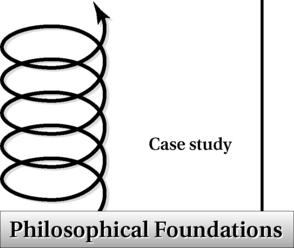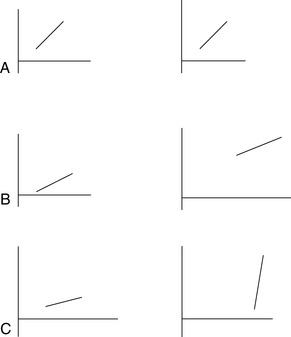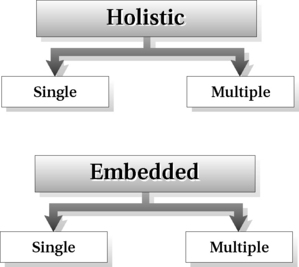Case Study Designs
Case study designs have typically been viewed as inferior to group or nomothetic designs (discussed in Chapter 8). However, over the past decade, the value and flexibility of case study designs are increasingly asserted by researchers and practitioners. Case study designs represent a methodology that can be quite complex.1 In this chapter, we examine case study methodology and suggest guidelines

for its use. We draw much of our discussion from the work of Yin, who has written extensively on case study and whose perspective is consistent with ours.
What is a case study?
Let us begin to understand case methodology by examining the definition advanced by Yin,2 who defined case study in two technical parts:
Part One: “An empirical inquiry that … investigates a contemporary phenomenon within its real life context; especially when the boundaries between phenomenon and context are not clearly evident.”
Part Two: “Copes with the technically distinctive situation in which there will be many more variables of interest than data points, and as one result, relies on multiple sources of evidence, with data needing to converge in a triangulating fashion, and as another result, benefits from the prior development of theoretical propositions to guide data collection and analysis.”2
It is usually assumed that case study is a design in which a single subject is investigated. However, you might have noticed that this element of case study designs does not even appear in Yin’s definition. The view that all case studies are investigations that focus on a single person is misleading. Rather, case study designs may involve multiple persons or units. The key element of case study design as illuminated by Yin is that it is an approach that is used to investigate a “single phenomenon” in context. A single phenomenon may be a single subject, a single part, or many subparts. For example, an investigator may be interested in a single family as the “case.” Because a family is composed of more than one individual, case study design may involve more than one person, with all the individuals making up one unit of analysis, the family.
Yin’s definition does not limit case study to a particular research tradition or design strategy; that is, a case study approach does not exclusively belong to experimental-type or naturalistic research. Rather, the approach is flexible; it can be conducted in either research tradition, or it can integrate both traditions. The purpose of a case study can be to describe phenomena, examine relationships, or make predictions.
Furthermore, a critical element of case study research is its reliance on multiple methods of data collection to capture the complexity of a case. Triangulation (more recently referred to as crystallization3; see Chapters 17 and 20), or collecting information using different strategies to examine a phenomenon, is a basic strategy in case study designs.2 In keeping with the flexibility of case study research, one can gather information using experimental-type or naturalistic techniques or their combination. Box 23-1 summarizes the four basic characteristics of case study.
Structure of case studies
There are many variations of case study designs that are labeled as single-subject, single-system, or “N of 1” single-case experimental trial (N refers to the size of the sample). A case study approach is useful in the following circumstances: (1) when it is not possible or desirable to randomize, (2) when it is not possible or desirable to study a particular population as a group with similar characteristics, (3) when it is desirable to determine intervention outcomes or change in a behavior over time as a consequence of one or multiple interventions, or (4) when it is desirable to obtain pilot information in a cost-efficient way. Moreover, case study is an excellent theory-generating tool because the findings of a single case can be theoretically explained and then tested through other types of design strategies.
To understand the different approaches to case study designs, we use Yin’s description of its structural components. Yin2 classified case studies into four categories created through combining two dimensions: the structure of the unit of analysis (holistic or embedded) and the number of cases (single or multiple; Figure 23-1). Let us examine each dimension now in more detail.
Structural Dimension
Two elements make up the structural dimension: holistic and embedded. Holistic case studies are those in which the unit of analysis is viewed as one global phenomenon. For example, if we were to select family function as our object of study, a holistic case study approach would treat the family as a single unit. In contrast, the embedded study would treat the family as multiple subparts or as subparts placed within larger contexts. Consider the following example.
When considering holistic versus embedded designs, the investigator must examine the nature of the phenomenon that is of interest as the basis for deciding how to proceed. Does the unit of analysis have natural parts that will reveal relevant information? If “yes,” then an embedded approach would be used. Does the “whole” provide the most informative approach? If “yes,” then a holistic approach is used.
Number of Cases
Now that you understand a holistic versus embedded approach, let us consider the differences between single-case and multiple-case designs. In a single-case design, only one study of a single unit of analysis is conducted. In a multiple-case design, more than one study of single units of analysis is conducted. It logically follows, therefore, that the holistic single-case study is conducted only once on one case. The holistic multiple-case study examines several global units of analysis more than once. Likewise, an embedded single-case study focuses on multiple parts of a single case using only one case. However, an embedded multiple-case study examines more than one case in which each case contains many subparts.
The decision to conduct a single-case or multiple-case study depends on several considerations. First, the aim of the research must fit the structure that is selected. Multiple-case studies enable the investigator to examine the same phenomenon across several different cases. It is somewhat analogous to the concept of “replication” in group (or nomothetic) designs. Thus, if an investigator wants to repeat a study to strengthen theory or test the findings of a single case on other cases, a multiple-case study approach is preferred. However, if the purpose of the research is to generate theory, explicate an atypical phenomenon, or describe the progress of an individual over time, a single-case study approach is warranted.
The reason an investigator would select a multiple-case study design instead of a more traditional group design lies in the definition of case study designs. Case study, whether single or multiple, is ideal for describing persons in depth and over time in their contemporary context without sacrificing or reducing the complexity of human experience.
Design sequence
Assume you plan to conduct a case study and have decided on its basic structure and size; that is, you have determined whether you will use a holistic or embedded, single-case or multiple-case approach. Deciding on basic structure and size is one of the first thinking processes involved in implementing a case study design. The second thinking process involves determining the sequence of the design.
Many types of case study design sequences can be used, depending on the purpose of the study and the questions and queries posed. Each design sequence has specific strengths and weaknesses. Some design sequences are more consonant with the naturalistic research tradition, in which the sequence is flexible and may change in the process of collecting and analyzing information. Alternatively, the design sequence may be linear and fixed, similar to experimental-type designs.
Experimental-Type Approach
Let us examine some of the more frequently used case study designs that follow an experimental-type structure. There are many strategies in this genre of single-subject research. Each strategy is based on the premise that the individual serves as his or her own control. Bloom et al.4 referred to the elements in single-subject design as “phases.” They noted that phases consist of distinct parts of intervention research, beginning with the baseline phase, in which no intervention occurs, proceeding to the intervention phase, and then ending with the follow-up phase. Many variations of these phases, including multiple intervention and follow-up phases, can be found in the case study research literature.
AB Design
Single-subject case study designs that follow experimental-type traditions have their own notation system similar to experimental-type design. However, different symbols are used. Rather than denoting the phases with X and O, case study uses A and B; A depicts the observation, and B indicates the intervention or independent variable. The most basic design is called the “AB design,” in which A represents the baseline phase and B represents the intervention phase. Although this type of design cannot predict, it can explain what happens during an intervention.
During the baseline period (A), repeated measures are obtained on specified variables. The investigator should obtain as many measurements as possible, typically from six to nine observation points, to establish a stable baseline. However, the number of measurements may vary depending on whether the observed behavior is stable. If, for example, observed scores are highly variable, many repeated measures may be necessary to detect a baseline pattern of behavior. It is important to establish a baseline pattern before introducing the intervention phase to be able to detect subsequent change.
After a baseline pattern has been established, the intervention is introduced, followed by repeated measurement. The A phase represents the measures that form the control measures. The B phase represents the measures that are obtained after intervention. The B phase measures are compared with those of the A phase. It is recommended that a similar number of observations be obtained in both the A phase and the B phase to examine the stability of change over time.
Remember that in Chapter 19, we discussed visual analysis. Because case studies examine a single unit of analysis, they often rely on visual techniques to reduce, display, and ascertain change. Let us now look at how investigators organize and visually represent their data for analysis in AB designs. After conducting the AB assessments, the investigator plots each score and performs a visual analysis to detect a change in the pattern of scoring between the A and B phases. Typically, a celeration line is drawn through the baseline data to facilitate visual inspection of observed scores. This line represents the “best fit” of the baseline data points. The same line is then drawn along the data points in phase B to determine whether there is a difference in the direction and placement of scores (Figure 23-2).

Figure 23-2 Celeration lines. A, No change: pattern returns to baseline and assumes the same trajectory. B, No change: pattern of change assumes the same trajectory. C, Change: pattern changes between first set of measurements and second set of measurements; trajectory is visibly different.
Variations. There are many variations on the AB design, such as the ABA and ABAB designs. In the “ABA design” a baseline period (A) is followed by an intervention period (B), which is then followed by the withdrawal of the intervention (A). In the “ABAB design” the previous sequence is followed, and then the intervention is reapplied.
Many more options can be introduced into designs that use phases A and B. For example, there may be multiple B phases in which each B phase may involve different therapeutic strategies. The structure of the ABA design is stronger than a simple AB sequence when there are questions regarding the extent to which change is produced as an outcome of an intervention.
Time Series Design
The time series design, another type of single-subject design, is used to follow one subject over time (see Chapter 9). Consider the following example.
Data Collection and Analysis
Now that we have discussed the basics of structure, size, and sequence, let us further explore the nature of data collection in single-case designs. As suggested by Yin,2 even when your study is consistent with the experimental-type tradition, multiple data collection strategies strengthen the credibility of findings in case study research. Ideally, the use of several measures at both baseline and follow-up phases should be used.
Data analysis of experimental-type case study designs is controversial. Although many consider it inappropriate to use statistical techniques to analyze single-subject data, other researchers disagree. Those who suggest that group analyses are not appropriate call our attention to sampling logic. For most statistical analyses, an underlying assumption is that a sample is selected to represent a population and that every effort is made to minimize bias that can be introduced through inadequate sampling. Because group sampling logic (discussed in Chapters 12 and 19) does not guide the selection of a case, statisticians suggest that the use of group analysis techniques is contraindicated. On the other end of the spectrum, investigators may subject multiple-case studies to group analyses. These investigators argue that group analysis of multiple cases is analogous to meta-analysis, in which investigators aggregate the findings of replicated studies and conduct secondary analysis of the data, even though the studies are not originally planned as part of the larger investigation.
Our position is that each of these perspectives is neither right nor wrong. The choice to use group analytical techniques for case study designs needs to be explicated, and a clear rationale for doing so should lie in the purpose and nature of the research question and the investigator’s view of knowledge. We suggest, however, that analytical strategies such as descriptive statistics, visual presentation of changes in quantitative measures, and inductive analyses of narrative information are the most useful analytical tools in case study designs. We urge investigators to consider these techniques before others in which the fit between design and analytical strategy may be tenuous.
A major concern in case study research for studies relying on experimental-type techniques is “generalizability.” There is a limitation to the external validity of a case study. However, its limited external validity is in part overcome by the ability to generalize findings to theory through replication, or the repetition of systematic single-subject studies, and the evaluation of each of these efforts as a whole.
Naturalistic Approach
Now let us look at case studies that are consistent with the naturalistic tradition. This approach to case study would be used when you are seeking (1) to generate theory in the absence of research literature, (2) to develop alternative theory, (3) to identify and develop lexical and operational definitions of important constructs for further measurement, or (4) to examine the complexity of your case in its natural context. As you would expect, these studies are flexible in structure, size, and sequence. It is possible to move between holistic and embedded designs or from single to multiple cases, depending on the emergence of insights as the study proceeds. What characterizes naturalistic case study and distinguishes it from other naturalistic designs is its logic structure, that is, the identification of a “case” as the phenomenon of interest. Let us consider the example of socialization in a community-based day program to illustrate.
Mixed-Method Approach
Consistent with Yin,2 we suggest that mixing experimental-type and naturalistic traditions in a single study is the best approach to designing and conducting case study research. The use of multiple measures of socialization combined with the findings from your field notes will tell you much more than either strategy could yield if used alone.
Summary
Case study represents an approach to systematic inquiry that can incorporate experimental-type, naturalistic, or mixed-method thinking and action processes. The case study approach is particularly helpful when little is known about a phenomenon and when aggregating or grouping responses across subjects does not allow sufficient insight into the phenomenon of interest. A variety of design structures and sequences are available to the researcher. Also, multiple data collection methods can be used and are desirable across the range of case study approaches.
The ability to use different design structures, methodologies, and data collection approaches makes the case study a flexible research option. A case study approach is useful under a variety of circumstances, especially to explicate in-depth understandings of a phenomenon, to examine change over time in one or more individuals, or to develop and examine a theoretical construct.
References
1. Stake, R.E. The art of case study research. Thousand Oaks, Calif: Sage, 1995.
2. Yin, R.K. Case study research: design and methods, ed 4. Newbury Park, Calif: Sage, 2009.
3. Denzin, N.K., Lincoln, Y.S. Sage handbook of qualitative research. Thousand Oaks, Calif: Sage, 2005.
4. Bloom, M., Fisher, J., Orme, J. Evaluating practice: guidelines for the accountable professional, ed 4. Boston, MA: Allyn & Bacon, 2009.


 You are interested in studying family violence. The investigator who believes that family violence is a cultural phenomenon may select a holistic single-case study design to analyze the response of the total family to cultural sanctions for violence. The family would therefore be observed and tested as a whole. In the embedded approach, individual members of the family are observed and tested as subparts of the single-family case study. This type of case study would be the design of choice for the investigator who is attempting to determine the dynamics among individual family members that may potentially provoke family violence.
You are interested in studying family violence. The investigator who believes that family violence is a cultural phenomenon may select a holistic single-case study design to analyze the response of the total family to cultural sanctions for violence. The family would therefore be observed and tested as a whole. In the embedded approach, individual members of the family are observed and tested as subparts of the single-family case study. This type of case study would be the design of choice for the investigator who is attempting to determine the dynamics among individual family members that may potentially provoke family violence.